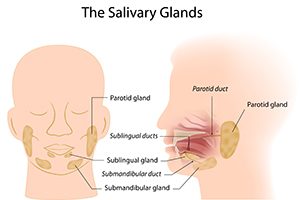Do You Have A Salivary Stone?
 A healthy flow of saliva is critical for chewing and digestion, bathing gums, and bacterial control. And we owe it all to salivary glands, three pairs of organs in the cheek and floor of the mouth. Each gland secretes saliva into the mouth via a tube, and this is where trouble can begin.
A healthy flow of saliva is critical for chewing and digestion, bathing gums, and bacterial control. And we owe it all to salivary glands, three pairs of organs in the cheek and floor of the mouth. Each gland secretes saliva into the mouth via a tube, and this is where trouble can begin.
Sialolithiasis—whew—names the condition that results from a small calcified stone blocking the salivary duct. Clearly, a kink in the duct will cause swelling of the gland itself.
And swelling usually means a measure of pain.
X-rays, ultrasound or an MRI will reveal any salivary gland blockage. In some people, stones recur again and again and may warrant minor surgery. Or a dentist, by fairly simple manual manipulation, can expel the stone and send you on your way.
Watch for:
- Swelling under the chin or just in front of your ear, especially while you’re eating and your glands are getting a workout.
- Any lack of saliva (we call it “dry mouth”).
- Pain in the jaw or a diffused discomfort in the bottom of the mouth.
![]()
About Yuri Kaneda, DDS
Dr. Yuri Kaneda was born in Japan and immigrated to the US when she was 4 years old with her family. She lived in Ohio, Nebraska, and Illinois before finally settling in the San Diego area. A graduate of Bonita Vista High School, she went on to the University of California Berkeley where she obtained her Bachelors in Microbiology and Immunology. After working for 2 years in growth plate research at University of California San Diego, she went to the University of California San Francisco Dental School for her Doctor of Dental Surgery degree. Upon graduation, she returned to San Diego where she worked as an associate in the practice of Drs. Morimoto and Yaryan, her childhood dentist. She then started her own practice in 1995 and has been at her present location since 1999 which happens to be across the street from her high school!
View all posts by Yuri Kaneda, DDS →
Appointments
To schedule an appointment please email us at [email protected].

